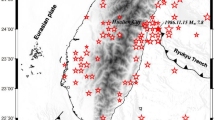Abstract
The observation of geomagnetic field variations is an important approach to studying earthquake precursors. Since 1987, the China Earthquake Administration has explored this seismomagnetic relationship. In particular, they studied local magnetic field anomalies over the Chinese mainland for earthquake prediction. Owing to the years of research on the seismomagnetic relationship, earthquake prediction experts have concluded that the compressive magnetic effect, tectonic magnetic effect, electric magnetic fluid effect, and other factors contribute to preearthquake magnetic anomalies. However, this involves a small magnitude of magnetic field changes. It is difficult to relate them to the abnormal changes of the extremely large magnetic field in regions with extreme earthquakes owing to the high cost of professional geomagnetic equipment, thereby limiting large-scale deployment. Moreover, it is difficult to obtain strong magnetic field changes before an earthquake. The Tianjin Earthquake Agency has developed low-cost geomagnetic field observation equipment through the Beijing–Tianjin–Hebei geomagnetic equipment test project. The new system was used to test the availability of equipment and determine the findings based on big data.
Similar content being viewed by others
References
Ni, Yuan, Wang, et al,2014, Analysis of local anomalous characteristics of lithospheric magnetic field before Ludian M6.5 and Yongshan M5.0 earthquakes in Yuannan in 2014:Journal of seismological research, 37(04), 537–541.
Wang, Chen,et al,2017,Lithosphere magnetic anomaly analysis of related faults of the 2014 Ludian MS6.5 earthquake:Journal of seismological research, 40(03), 377–381.
Ginzburg, Frumkis,et al,2002,Processing of magnetic scalar gradiometer signals using orthonormalized functions:Sensors and actuators A-Physical, 102(1/2):67–75.
Luo, Lin, et al, 2021, Design of vessel magnetic field signal acquisition system based on RM3100 magnetic sensor:Transducer and microsystem technologies, 40(2):86–88.
Chen, Yuan, et al, 2017, Data processing flowchart of chinese mobile geomagnet monitoring array:Journal of seismological research, 40(03):335–339.
Ren, Xu, 2014, Principle and application of MSP430 microcontroller:Publishing house of electronics industry, Beijing, CHN, 231–246.
Wei,2002,MSP430 series single chip microcomputer interface technology and system design example:Beihang university press, Beijing, CHN, 146–164.
Yang, Wang,et al,2020,Characteristics of lithospheric magnetic field and seismomagnetic characteristics in Yunnan area:Journal of seismological research, 43(04), 745–750.
Yu, Lin,2018,Detection system of ship’s magnetic field signal based on PNI magnetic sensor:Mine warfare & ship self-defence, 1 (03), 54–57.
Sun, Jiang,2020,Adaptive algorithm for attitude estimation for UAV based on MEMS and geomagnetic:Transducer and microsystem technologies, 39(11), 122–125.
An, Wang,et al,2020,Ellipsoid fitting compensation method for three-axis magnetometer on projectile:Transducer and microsystem technologies, 39(12), 4–6.
Zhou,2021,The method of electronic compass to eliminate the interference of fixed position and variable magnetic field:Adhesion, 47(08),158–161.
Wu, Feng,et al,2011,Study on electronic compass based on MEMS 3D magnetoresistive sensor:Transducer and microsystem technologies, 30(08), 83–88.
Wu, Teng,et al,2012,A new type of algorithm for rebuilding the trace of free-fall body in absolute gravimeter development:Acta seismologica sinica, 34(04), 549–556.
Zhou, Li,2020,Common sensor technologies and applications(Second edition):Publishing house of electronics industry, Beijing, CHN, 314–336.
Zhang, Lin,et al,2011,Detection of magnetic anomaly signal based on OBF decomposition in wavelet domain:Journal of projectiles,rockets,missiles and guidance, 31(06):187–196.
Li, Niu,et al,2022,Design and implementation of smart mobile office system based on uni-app and springboot:Journal of southwest university for nationalities(Natrual science edition), 48(03), 313–321.
Wang, Liu,et al,2021,Development and application of an integrated management system for basic data of underground fluid network in Tianjin:China earthquake engineering journal, 43(05):1014–1023.
Tai, Tseng,et al,2004,Real-time image tracking for automatic traffic monitoring and enforcement applications:Image and vision computing, 22(06), 485–501.
Yang, Tang,et al,2013,Earth science research in U.S.Geological survey under the big data revolution:Geological bulletin of china, 32(09):1337–1343.
Zhang, Chen,2017,The challenges brought by dense seismic observation:Journal of seismological research, 40(01):1–14.
Acknowledgments
During the development and testing of the low-cost magnetic field monitoring equipment, Lv Chuanzhen from the First Monitoring Center of China Earthquake Administration, Ma Sheng and Zhao Jing from the Department of Artificial Intelligence and Computing of Tianjin University gave great support and help. The project team expressed heartfelt thanks to them.
Author information
Authors and Affiliations
Corresponding author
Additional information
This work was supported by the Spark Program of Earthquake Science and Technology(No.XH23003C).
Author Biography: Sun Lu-qiang is a senior engineer at Tianjin Earthquake Agency. He graduated from Tianjin University of Technology in 2008 with a master’s degree in Computer Science and Technology. He is currently engaged in research on earthquake warning risk prevention and new technologies for earthquake monitoring. He is the winner of the title of young talents of China Earthquake Agency. He serves as the leader of the innovation team of the Tianjin Earthquake Agency.
Rights and permissions
About this article
Cite this article
Sun, LQ., Bai, XF., Kang, J. et al. Design and implementation of low-cost geomagnetic field monitoring equipment for high-density deployment. Appl. Geophys. (2023). https://doi.org/10.1007/s11770-023-1015-1
Received:
Revised:
Published:
DOI: https://doi.org/10.1007/s11770-023-1015-1




